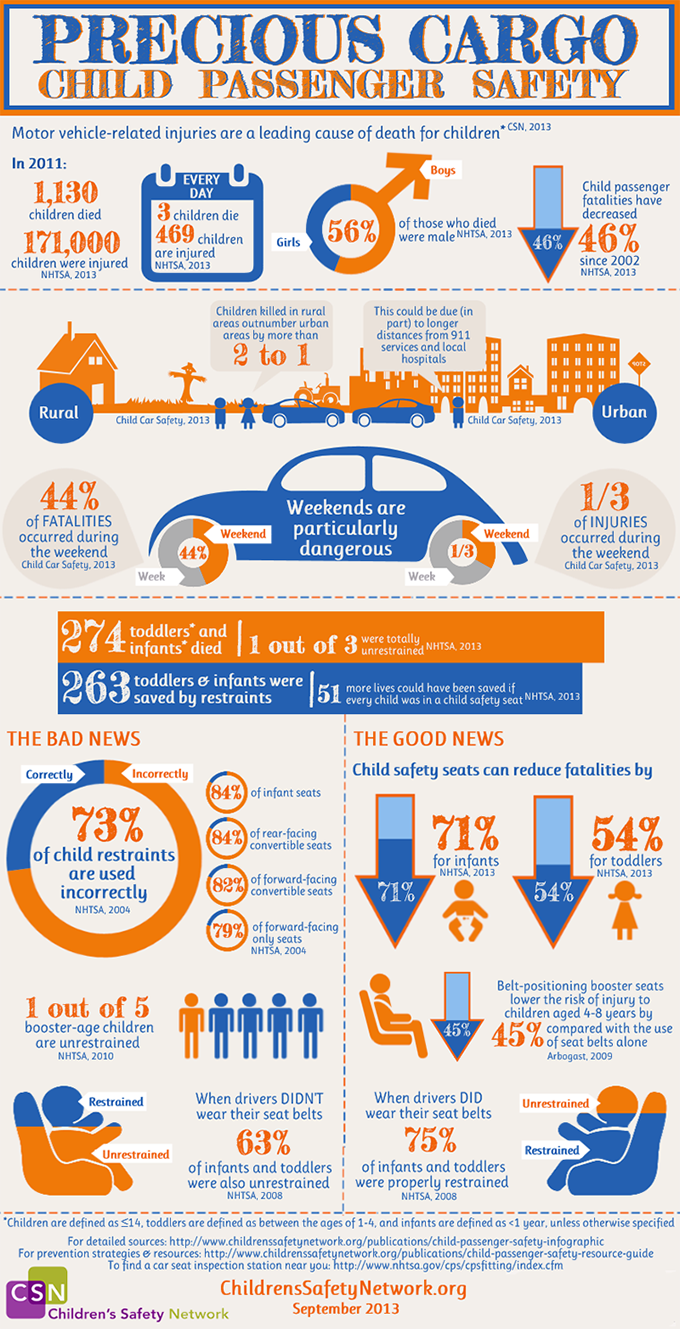
Though child passenger fatalities have decreased, motor vehicle-related injuries are still a leading cause of death for children. Proper use of child restraints can significantly reduce the risk of injury and death for children. Unfortunately, many child restraints are used incorrectly. This infographic has information on risk factors, child restraint use and misuse, and more.
PRINT version of Precious Cargo: Child Passenger Safety infographic with sources
Read our blog post on Child Passenger Safety: Using the Right Seat Correctly
Read our Child Passenger Safety Resource Guide
PRECIOUS CARGO: CHILD PASSENGER SAFETY
Motor vehicle-related injuries are a leading cause of death for children* (Children’s Safety Network (CSN), 2013)
IN 2011:
1,130 children died and 171,000 were injured in motor vehicle crashes. Every day, 3 children die and 469 children are injured (National Highway Traffic Safety Administration (NHTSA), 2013)
56% of those who died were male (National Highway Traffic Safety Administration (NHTSA), 2013)
Child passenger fatalities have decreased 46% since 2002 (National Highway Traffic Safety Administration (NHTSA), 2013)
Rural/Urban:Children killed in rural areas outnumber urban areas by more than 2 to 1. This could be due (in part) to longer distances from 911 services and local hospitals (Child Car Safety and National Highway Traffic Safety Administration (NHTSA), 2013)
Weekends are particularly dangerous.44% of fatalities occurred during the weekend; a third of all injuries occurred during the weekend (Child Car Safety and National Highway Traffic Safety Administration (NHTSA), 2013)
THE BAD NEWS
274 toddlers*/infants* died. 1 out of 3 were unrestrained (National Highway Traffic Safety Administration (NHTSA), 2013)
73% of child restraints are used incorrectly (National Highway Traffic Safety Administration (NHTSA), 2004)
- Infant seats: 84% misused
- Rear-facing convertible: 84% misused
- Forward-facing convertible: 82% misused
- Forward-facing only: 79% misused (National Highway Traffic Safety Administration (NHTSA), 2004)
1 out of 5 booster-age children are unrestrained (National Highway Traffic Safety Administration (NHTSA), 2010)
When drivers didn’t wear their seat belts, 63% of children up to age 4 were also unrestrained. (National Highway Traffic Safety Administration (NHTSA), 2008)
THE GOOD NEWS
263 toddlers and infants were saved by restraints. 51 more lives could have been saved if every child was in a child safety seat (National Highway Traffic Safety Administration (NHTSA), 2013)
Child safety seats can reduce fatalities by
- 71 percent for infants (younger than 1 year old)
- 54 percent for toddlers (1 to 4 years old) (National Highway Traffic Safety Administration (NHTSA), 2013)
Belt-positioning booster seats lower the risk of injury to children aged 4-8 years by 45% compared with the use of seat belts alone (Arbogast, Jermakian, Kallan, & Durbin, 2009)
When drivers did wear their seat belts, 75% of children up to age 4 were properly restrained. (National Highway Traffic Safety Administration (NHTSA), 2008)
ABOUT
*Children are defined as ≤14, toddlers are defined as between the ages of 1 and 4, and infants are defined as <1 year, unless otherwise specified
To view the infographic on our website: http://www.childrenssafetynetwork.org/publications/child-passenger-safety-infographic
For prevention strategies & resources: http://childrenssafetynetwork.org/publications/child-passenger-safety-resource-guide
SOURCES
Arbogast, K. B., Jermakian, J. S., Kallan, M. J., & Durbin, D. R. (2009). Effectiveness of belt positioning booster seats: an updated assessment. Pediatrics, 124, 1281–1286.
Child Car Safety and National Highway Traffic Safety Administration (NHTSA). (2013). Additional Statistics - Child Passenger Safety Week 2013. Retrieved from http://www.trafficsafetymarketing.gov/cps
Children’s Safety Network (CSN). (2013). United States 2013 Fact Sheet. Retrieved from http://www.childrenssafetynetwork.org/state/united-states
National Highway Traffic Safety Administration (NHTSA). (2004). Misuse of Child Restraints. Retrieved from http://www.nhtsa.gov/people/injury/research/tsf_misusechildretraints/images/809851.pdf
National Highway Traffic Safety Administration (NHTSA). (2008). FACTS: Children, Youth, Young Adults. Retrieved from http://www.nhtsa.gov/DOT/NHTSA/Traffic Injury Control/Articles/Associated Files/810654.pdf
National Highway Traffic Safety Administration (NHTSA). (2010).Reducing Nonuse of Restraints by Children Ages 5 to 7. Retrieved from http://www.nhtsa.gov/staticfiles/traffic_tech/tt382.pdf
National Highway Traffic Safety Administration (NHTSA). (2013). 2011 Children Traffic Safety Fact Sheet. Retrieved from http://www-nrd.nhtsa.dot.gov/Pubs/811767.pdf